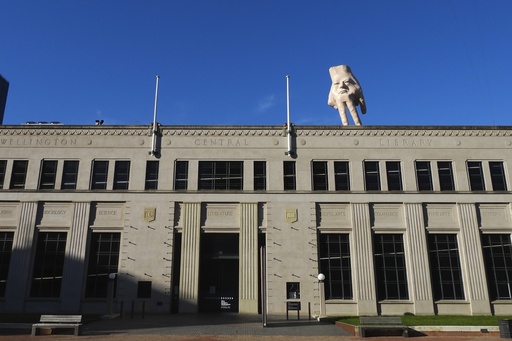
In Wellington, New Zealand, a massive hand sculpture has stood on the roof of the City Gallery for the past five years. This striking artwork, named Quasi, features a grim-faced figure and measures around 16 feet (nearly 5 meters) tall. Created by Australian sculptor Ronnie van Hout, the sculpture has stirred a mix of feelings among local residents, ranging from horror to amusement. However, the decision has been made to remove Quasi from its perch atop the gallery this week, as announced by the gallery on Wednesday.
Wellington city council member Ben McNulty summed up the significance of the sculpture’s exit, stating, “This is either a great day for Wellington or a terrible day for Wellington, and there’s not much view in between.” On a personal note, McNulty expressed his sadness about the hand’s departure, calling himself “devastated.”
Constructed from steel, polystyrene, and resin, Quasi was primarily modeled using scans of van Hout’s own hand and face. The name is a nod to Quasimodo, the iconic character from Victor Hugo’s classic novel, “The Hunchback of Notre-Dame,” which explains the male attributes some observers have associated with the piece.
Quasi made its debut at an art gallery in Christchurch in 2016, where it quickly became a topic of heated discussions. One local publication even ran an op-ed arguing for its removal, stating that its extended finger looked as if it was menacing pedestrians and office workers. Van Hout defended his creation humorously, suggesting that perhaps the statue just wanted some love.
In 2019, Quasi was relocated to Wellington, where its relationship with the local populace evolved. Initially, many found it perplexing or unsettling, with McNulty recalling that roughly 80% of residents viewed it with disdain. However, over the years, sentiments began to shift. McNulty identified a growing faction of supporters who began to embrace the sculpture.
As the announcement of Quasi’s removal approached, many people gathered in Civic Square, expressing their newfound fondness for the artwork. Anja Porthouse, who visited with friends and family, described the sculpture as “disturbing but a staple of Wellington,” and lamented its departure.
The helicopter is set to lift Quasi off the gallery’s roof this Saturday, with plans for the giant hand’s installation at a yet-to-be-revealed location in Australia. On social media, reactions varied, ranging from sadness and humor to local folklore suggesting Quasi might bring a curse after its removal. McNulty pointed out that the sculpture has provided a backdrop through some of Wellington’s more challenging moments, including issues with earthquake safety and political disputes.
Speculations about Quasi’s next destination continued, with one resident quipping that it was “going to The Hague.” Jane Black, chair of the Wellington Sculpture Trust, echoed feelings of loss, saying, “He will be missed.” Meanwhile, city mayor Tory Whanau shared a different sentiment, expressing relief at the change, stating, “I think there’s a strong feeling of relief” regarding Quasi’s departure.
